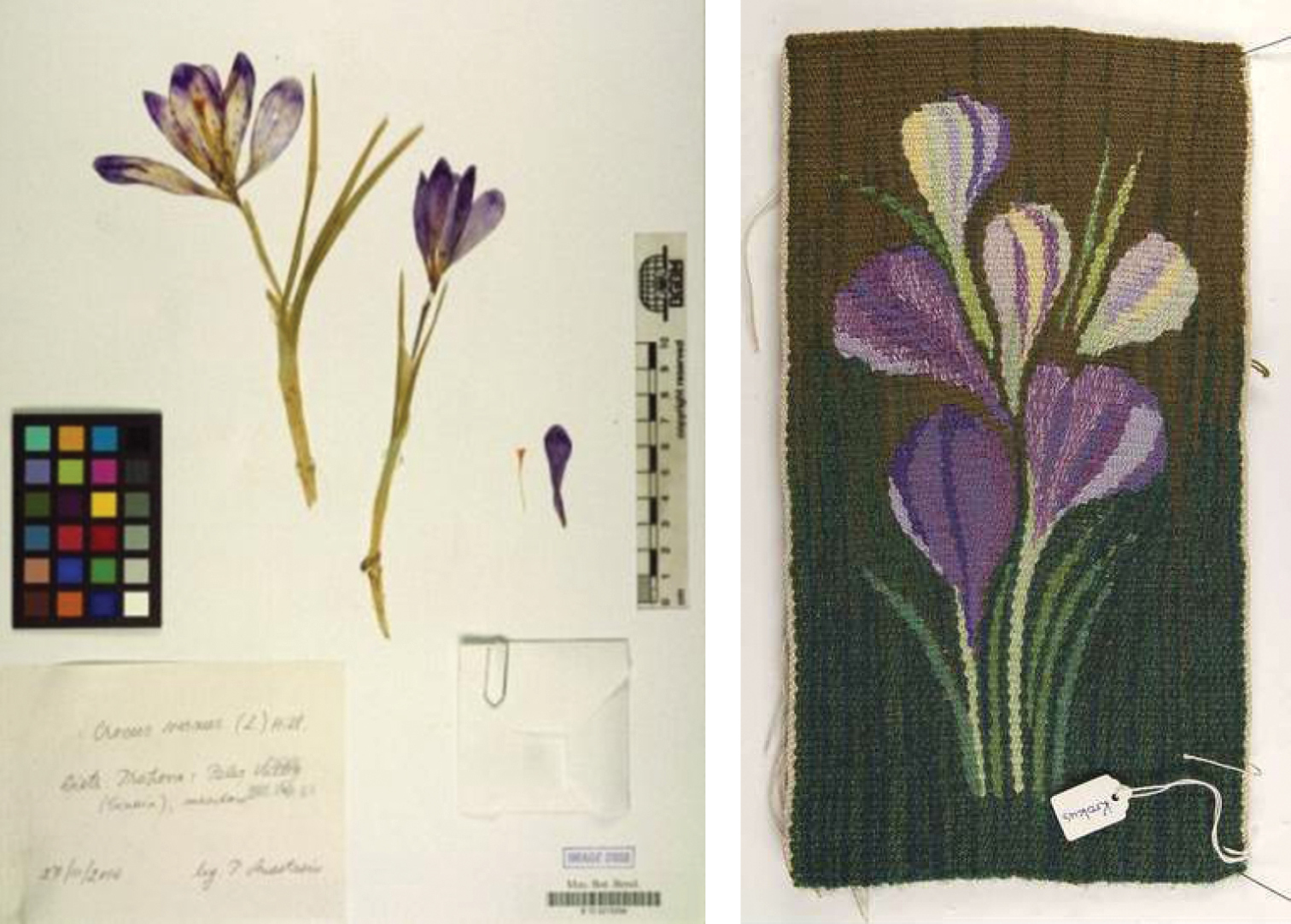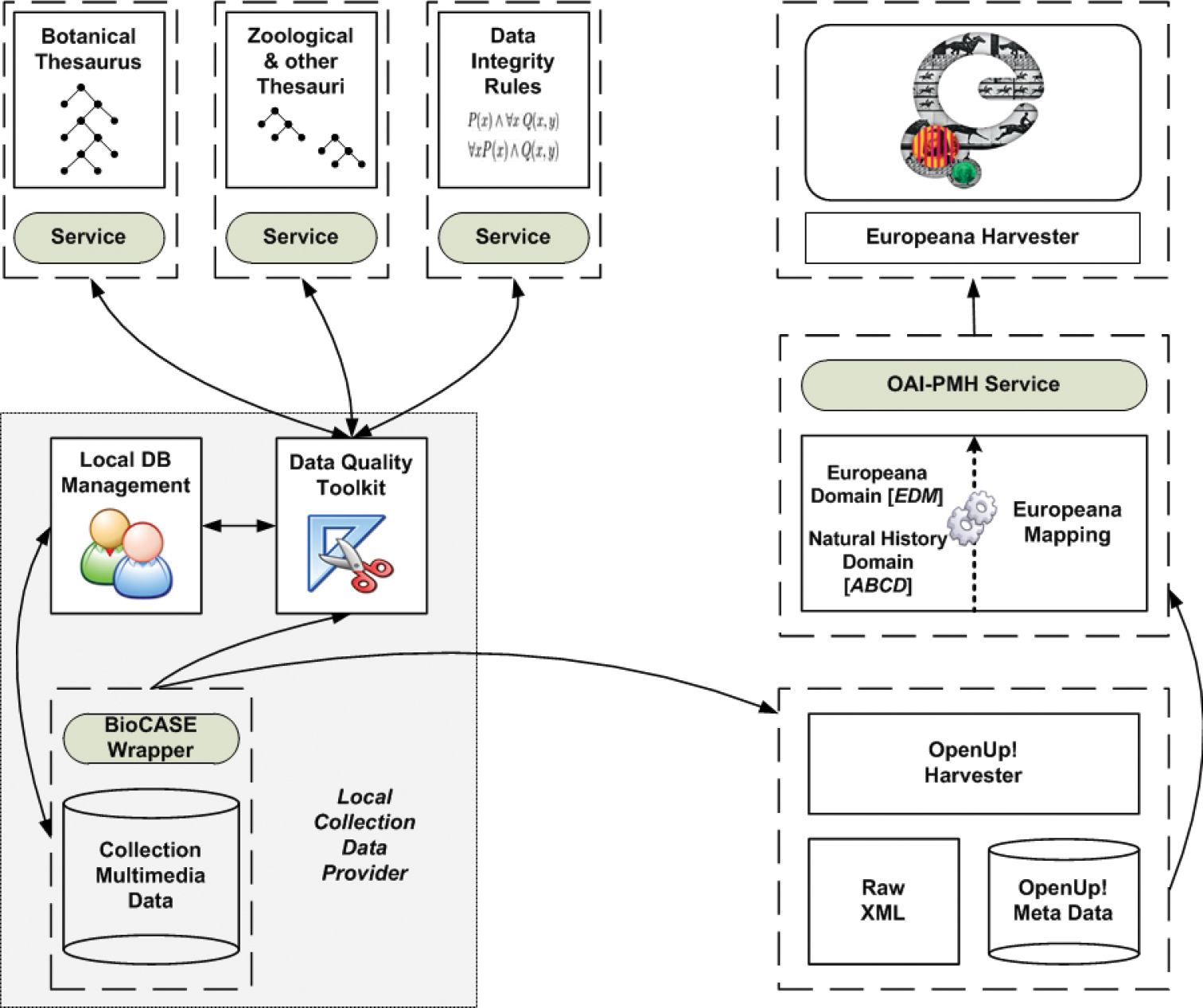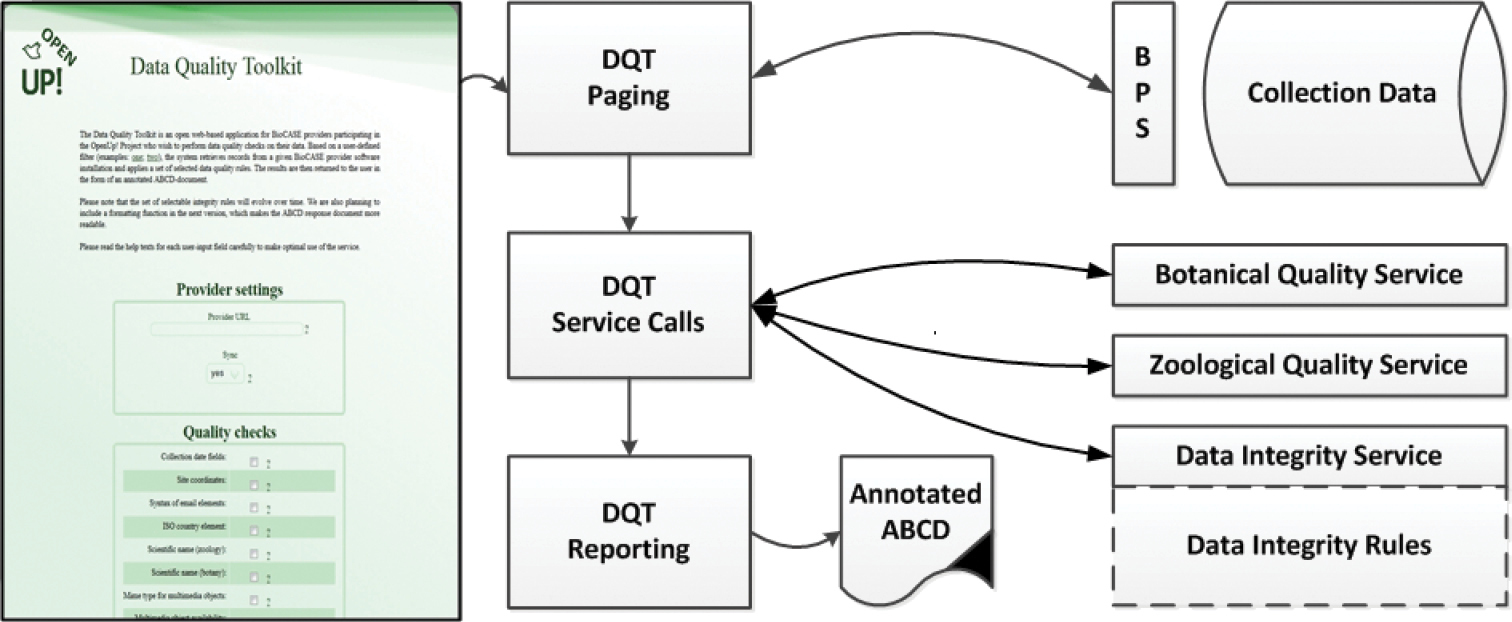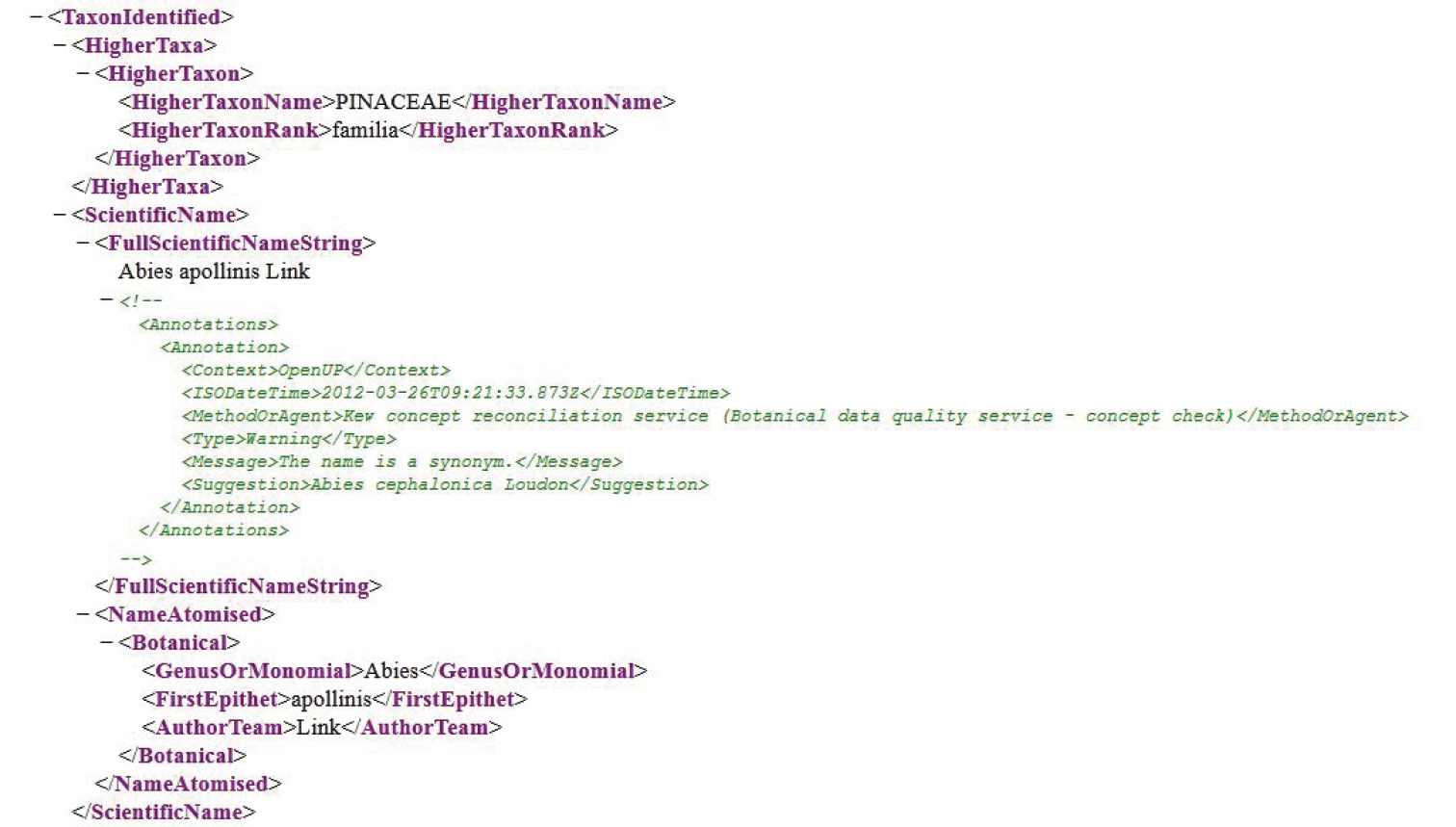






(C) 2012 Walter G. Berendsohn. This is an open access article distributed under the terms of the Creative Commons Attribution License 3.0 (CC-BY), which permits unrestricted use, distribution, and reproduction in any medium, provided the original author and source are credited.
For reference, use of the paginated PDF or printed version of this article is recommended.
Multimedia data held by Natural History Museums and Universities are presently not readily accessible, even within the natural history community itself. The EU project OpenUp! is an effort to mobilise scientific biological multimedia resources and open them to a wider audience using the EUROPEANA data standards and portal. The connection between natural history and EUROPEANA is accomplished using well established BioCASe and GBIF technologies. This is complemented with a system for data quality control, data transformation and semantic enrichment. With this approach, OpenUp! will provide at least 1, 1 Million multimedia objects to EUROPEANA by 2014. Its lean infrastructure is sustainable within the natural history community and will remain functional and effective in the post-project phase.
OpenUp!, BioCASe, EUROPEANA, GBIF, Multimedia, ABCD, ESE, EDM, Biodiversity Informatics, Collections, Natural History
The vast majority of global collections of biological organisms and images of organisms are held by institutions such as natural history museums and universities, in the realm of natural sciences. Nevertheless, nature is of course a major subject in the context of cultural history and humanities, and numerous cultural objects represent organisms (Fig. 1). Both communities have started to digitise their objects and to publish the resulting multimedia data to make them accessible to a wider audience. The prevalent disjunction between them, however, has led to procedures, technologies, and data standards being optimized for the respective community’s needs. The resulting incompatibilities prevent semantic linking and joined access.
In fact, there is a significant need for convenient joint access to the collection and multimedia holdings of different scientific communities. In the context of art history, for example, access to plant identifications provided by herbaria can be an important tool for the analysis of, e.g., ornaments in works of art. In turn, linking artwork with natural history specimens raises the general awareness of this important research tool and thus serves the museum community. And cultural background may be documented with natural history specimens; e.g. the collections during famous expeditions like those of Humboldt and Bonpland, and data on local uses recorded with the description of the collected organism.
EUROPEANA is the European portal to museums, libraries, archives, and audio-visual collections (
Of course we are fully aware of the problems of semantic mapping of metadata, especially with the taxonomic concepts represented by the name (e.g.
Herbarium specimen Crocus vernus L. (© Botanic Garden and Botanical Museum Berlin-Dahlem, Germany) and Tapestry called Krokus by Britta Rendahl (1976) (© Upplandsmuseet, Uppsala, Sweden).
OpenUp! creates an information flow from holders of collection multimedia data to the EUROPEANA data portal and services, but it avoids as much as possible the development and deployment of project-specific software modules. Rather, existing and well established protocols, standards, and software tools are used, resulting in an infrastructure that can be maintained with low maintenance costs beyond the funded project phase (Fig. 2).
OpenUp! data providers are usually connecting their existing collection management databases to the network. These databases are part of their institutional work flow so that maintenance and updating is part of the institutional setup. Connection is accomplished by equipping the local database with an installation of the BioCASe provider software package (
Harvesting of ABCD data and storage on the central aggregation server is performed using the GBIF Harvesting and Indexing Toolkit (HIT,
OpenUp! metadata are periodically harvested by EUROPEANA via a single OAI-PMH access point at the aggregator database. Previews of multimedia objects for presentation and queries in the EUROPEANA portal are generated by EUROPEANA from full object URLs given in the metadata. The object itself and its presentation (e.g. using an image server or streaming software for audio files) stay with the provider, who also retains full rights of the multimedia file. The existence of the file is checked during the ABCD/ESE conversion process. Additionally, the central OpenUp! server will cyclically check the links to multimedia files and warn data providers if files become unavailable. In case of enduring problems, the links metadata will be excluded from the process.
Information flow from a collection data provider via the central OpenUp! aggregator to the EUROPEANA harvester and portal. The collection database uses standard BioCASe/ABCD technology for connecting up to the network.
Organising the basic information flow and data transformation process from biological multimedia collections to the EUROPEANA portal took considerable project resources. However, improving the content with regard to data quality and usability is the main item in the OpenUp! budget (which is co-funded by the European Union and the participants in the project). To support this process, some tools were implemented to support providers in the detection of data quality problems in their databases. Again, this “Data Quality Toolkit” mostly relies on existing systems and only a relatively lightweight interface layer is specific to OpenUp!
The OpenUp! Data Quality Toolkit (Fig. 3) operates directly on a given individual installation of the BioCASE provider software. It pages through a subset of ABCD records defined in its web-based user interface (
By decoupling the Data Quality Toolkit user interface layer from the underlying data quality services, the services themselves can be used in other contexts, and in turn, OpenUp! can integrate data quality services provided by other projects or initiatives. Collaborations have already started with the EU project BioVeL (Biodiversity Virtual e-Laboratory,
The OpenUp! Data Quality Toolkit
OpenUp! Data Quality Toolkit annotation indicating that an identification is using a name which is a synonym (according to a concept reconciliation service provided by Kew Gardens).
The impact of the presentation of natural history specimens in a cross-domain context like EUROPEANA will partly depend on the possibilities for semantic linking with other content. Semantic linking is made possible by the metadata provided, so it can be enhanced by enriching the domain vocabularies used by the providers in the metadata. For example, in natural history databases typically the Latin scientific name is entirely sufficient (and indeed the most precise way) to denote the identification of the specimen. In contrast, content from the cultural domain will usually refer to an organism by means of a common name. Users from that domain would not find the corresponding natural history object with their searches. Enhancing the natural history metadata by adding common names will close that gap.
In OpenUp! the botanical and zoological name services will be used to add synonym lists to the Latin names provided by the collection holders. A forthcoming OpenUp! service will be used for adding multilingual common names to the scientific names. In addition, external services will be used for adding further geographic information to the place names contained in the specimen data.
OutlookDuring the first project year, OpenUp! has mobilised more than 220, 000 natural history multimedia objects and made them available through EUROPEANA and GBIF, and the numbers are rapidly growing. Specimens displayed in the EUROPEANA portal demonstrate the feasibility of the principle data flows in OpenUp!. However, they also brought to light the weakness of the portal or in fact of the underlying ESE standard. Multimedia objects representing collection objects often have a strong relation to each other (e.g. several images from one specimen), which the portal does not adequately represent in its present stage. With the transition to the new metadata standard EDM (Europeana Data Model,



